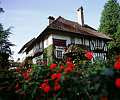20. Thiago Silva (free agent, joining AC Milan in June)
The 24-year-old, converted to centre back after being a utility man, left Fluminese last year. Rebuilt his career after failing to make an impact in previous European spells and will be at the San Siro next season after appearing at the Olympics as an overage player.
19. Mario Balotelli (Inter Milan)
This 18-year-old Italy under-21 striker, born in Sicily to Ghanaian parents, made his Inter first-team debut at the end of 2007 and is highly-rated though has struggled for action under Jose Mourinho.
18. Angel Di Maria (Benfica)
An Arsenal target in 2007, the 20-year-old Argentina midfield player with a headline-friendly name scored the winner in the Olympic final last year and is one of Chelsea’s key transfer targets for the summer.
17. Adam Johnson (Middlesbrough)
Surprisingly linked with Real Madrid last month – he’s not quite ready for them yet - the 21-year-old has the potential to be Teesside’s new wing wizard if and when Stewart Downing moves on.
16. Diego Buonanotte (River Plate)
The tiny 20-year-old attacking midfield player with excellent dribbling ability featured in Argentina’s Olympic gold medal-winning side last year and has become a key figure at his club.
15. Sofiane Feghouli (Grenoble)
Dubbed the “new Zidane”, along with half the teenage midfield players in France, the 19-year-old Parisian has apparently come to the notice of Liverpool, Chelsea, Manchester United and Blackburn Rovers.
14. Ezequiel Lavezzi (Napoli)
The Argentina forward is reportedly interesting Chelsea but his club this month said they are determined to hang on to the 23-year-old, who is viewed in Naples as one of the club’s brightest stars since Diego Maradona.
13. Steve Mandanda (Marseilles)
The Kinshasha-born goalkeeper had an unsuccessful trial at Aston Villa in 2007, but since he became first-choice at the Stade Velodrome he has gone from strength to strength and is now between the posts for France.
12. Marek Hamsik (Napoli)
A Slovakia international, the 20-year-old goalscoring midfield player moved from Slovan Bratislava to Brescia in 2004, then to Napoli in 2007 and is highly popular. When his watch was stolen last month, fans tracked down the thieves and recovered it.
11. Carlos Eduardo (Hoffenheim)
European scouts had kept tabs on this Gremio left-sided midfield player as a teenager, but it was to little Hoffenheim that he moved for €8 million in 2007. He is now 21 and Hoffenheim are shock contenders for the Bundesliga title.
10. Claudio Marchisio (Juventus)
A Turin-born Juve youth product long hailed as one of Italy’s brightest talents, the 22-year-old has shown this season that he is capable of dominating central midfield.
 9. Fabio Da Silva (Manchester United)
9. Fabio Da Silva (Manchester United)
His twin Rafael, has already caught the eye at right back this season and the word from Old Trafford is that Fabio, 18, is just as exciting – though he is yet to make his United debut given Patrice Evra’s excellence at left back.
8. Jozy Altidore (Villarreal)
Strong, quick and a good finisher, the New Jersey-born striker is the hottest property to come out of Major League Soccer since Freddy Adu. Altidore made a big-money move to Spain last summer.
7. John Fleck (Rangers)
The nephew of the former striker, Robert Fleck, he became the youngest player to feature in a Scottish Cup final last May and is a 17-year-old attacker with prodigious talent who has generated plenty of buzz.
6. Jack Wilshere (Arsenal)
Of all Arsenal’s adolescents, this Stevenage-born 17-year-old midfield player is perhaps the most exciting, and he has already featured in two Champions League games this season. 
5. Douglas Costa (Gremio)
The new Ronaldinho? The new Anderson? Either way, this skilful 18-year-old midfield player attracted the attention of Manchester United and Real Madrid last autumn despite making just a handful of appearances. His buy-out clause is 21 million GBP.
4. Radamel Falcao Garcia (River Plate)
The 22-year-old Colombia striker, named after the former Brazil star, Falcao, is quick, lethal and two-footed and leading European sides are eyeing up this potential star.
3. David Silva (Valencia)
A Liverpool and Barcelona target last summer after he starred for Spain at Euro 2008, the diminutive winger, just turned 23, has fabulous skills and a determined character.
2. Karim Benzema (Lyons)
Lyons placed a 100 million Euro price-tag on this academy product to deter the hordes of bigger clubs eyeing up the 21-year-old France striker, who has few weaknesses in his game and is a bona fide superstar in the making.
 1. Hernanes (Sao Paulo)
1. Hernanes (Sao Paulo)
Perhaps the most-hyped South American prospect of last year, the hugely-talented 23-year-old Brazilian is an attacking midfield playmaker, leading to inevitable Kaka comparisons. How long before he moves to Europe?
sourse (times)




















